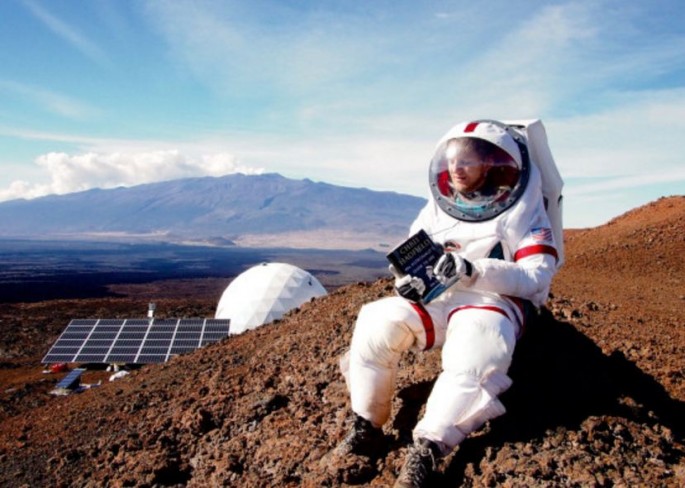A multinational crew of six scientists pretending to be astronauts on Mars will finally step into the real world to end a one-year experiment in extreme isolation on a camp along the desolate slopes of the Mauna Loa volcano in Hawaii.
The three men and three women from the United States, Germany and France will exit the HI-SEAS (Hawaii Space Exploration Analog and Simulation) simulated Mars base on Aug. 28, or 365 days after they first entered the isolated complex with its many Mars-like features such as dusty soil and the absence of plants.
This group of volunteers belong to HI-SEAS IV, the fourth in a series of simulations that began in 2013. HI-SEAS IV is the longest simulation yet. HI-SEAS has been described as an analog habitat for human spaceflight to Mars that simulates long duration space exploration.
NASA's Human Research Program has funded and sponsored all the HI-SEAS expeditions. NASA funded the study through the University of Hawaii.
The purpose of HI-SEAS is to determine what's required to keep a space flight crew happy and healthy during an extended mission to Mars and while living on Mars. A one-way trek to Mars could take as long as nine months.
Research into crew dynamics, behaviors, food, roles and performance and other aspects of space flight and a mission on Mars itself is the primary focus of HI-SEAS.
While coping with their limited resources, the volunteers conduct research and try to avoid personal conflicts. Communication is delayed by 20 minutes, the length it would take to relay messages from Mars.
"They're doing OK, as far as we can tell," said Kim Binsted, principal investigator for HI-SEAS.
The six scientists lived in a solar powered dome atop Mauna Loa. HI-SEAS IV focused on crewmember cohesion and performance. HI-SEAS researchers want to develop effective team composition and support strategies to allow crews to successfully travel to Mars and back.
The crew was monitored using cameras, body movement trackers, electronic surveys and other methods. UH Mānoa researchers and their collaborators are studying the group's cohesion over time, gathering data on a wide range of cognitive, social and emotional factors that may impact team performance.
HI-SEAS IV consists of:
* Carmel Johnston, a soil scientist from Montana, who joined HI-SEAS to research food production in Mars simulation. She holds a Bachelor of Science in Soil and Water Science and a Master of Science in Land Resources and Environmental Sciences from Montana State University.
* Christiane Heinicke, a German physicist and engineer, recently she has worked on sea ice and has also gained experience working with polar lights, metal melts and simulations of the Earth's mantle. She received her bachelor of science in applied physics from the Ilmenau University of Technology in Germany and her master of science in geophysics from Uppsala University in Sweden and her PhD from the Ilmenau University.
* Sheyna Gifford has worked on research projects in astrophysics, neuroscience and psychology and is a contributor to NASA educational websites, a medical writer and an advocate of STEM education. She holds a bachelor of science in neuroscience and English, a master of clinical laboratory science and biotechnology, a master of science in journalism, a doctor of medicine from the St. Georges University School of Medicine located in the Caribbean island of Grenada, and is currently earning a master of business administration.
* Andrzej Stewart worked as an interplanetary flight controller at Lockheed Martin and also worked on console for the Spitzer Space Telescope, Mars Odyssey, MRO, MAVEN, Juno and GRAIL. Stewart also served as the flight engineer for the sixth mission of NASA's Human Exploration Research Analog (HERA). He earned a bachelor of science in aerospace engineering from the University of Texas at Austin in 2005 and an SM in aeronautics and astronautics from MIT in 2007.
* Cyprien Verseux is an astrobiologist expert in biological life support systems for Mars exploration. At the time of the mission, he is a doctorate student co-directed by Lynn J. Rothschild at NASA, and Daniela Billi at the University of Rome. He previously graduated from the Institut Sup'Biotech de Paris where he was first-in-class each semester, and from the Institute of Systems and Synthetic Biology, where he graduated valedictorian. Part of his research aims at making human outposts on Mars as independent as possible of Earth by using living organisms to process Mars' resources into products needed for human consumption.
* Tristan Bassingthwaighte is a doctor of architecture candidate at UH Mānoa. He completed his master's degree in architecture from Tongji University in Shanghai, where he studied abroad for a year looking at human habitation in extreme environments. His doctoral work involves designing a next generation conceptual Mars habitat focused on programming the interior experienced environment.



























